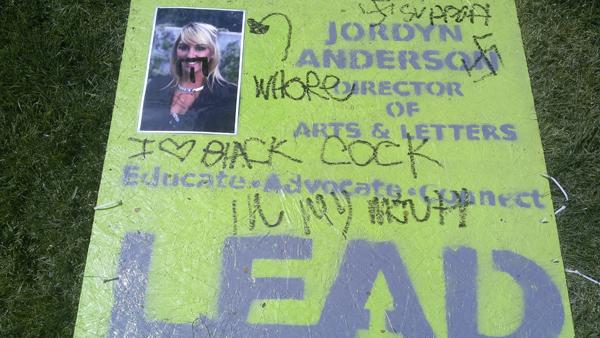Vandalism on campus makes personal attacks on ASI candidate

April 23, 2013
Although graffiti is an appealing art form for some, at Sacramento State, graffiti has become the mark of vandalism and is damaging to more than just property.
Sac State has seen its share of vandalism, including the recent defacement of ASI candidate Jordyn Anderson’s campaign board.
On the board were sexually explicit words and illustrations.
Anderson said she did not know the degree of vandalism until she arrived on campus.
“I definitely was very upset just hearing about it over the phone, and then, as soon as I got on campus and saw everything – all of the horrible things that were written – I was extremely embarrassed,” Anderson said.
ASI President Monica Cortez said the vandalism on Anderson’s poster seemed like a personal attack.
“(The candidates) paid for that. They were working really hard to do that. It doesn’t matter who it would’ve been – regardless, anyone. No one deserves that,” Cortez said.
Anderson said because the graffiti was only on her board it was more than just graffiti to her.
“I felt like this was more like a personal attack – (it was) kind of harassment. So I thought it went a little bit beyond just general graffiti,” Anderson said.
Cortez said a similar incident occurred last year in the quad where half of the candidates’ poster boards were vandalized with sexual illustrations and writing about school fees.
“It was reported to campus (police department) because it was just kind of like ‘whoa.’ All the students were (like) ‘What happened?” Cortez said.
Sac State Police Chief Mark Iwasa said vandalism is a misdemeanor crime.
“Typically, if the individuals are caught they go through the court process for misdemeanor prosecution. In many cases, it leads to some type of probation or fine. Very rarely would (it) result in incarceration,” Iwasa said.
According to Sac State’s facilities department, it costs $66.85 in repairs for every call about graffiti and there were an estimated 110 graffiti calls in 2012.
Iwasa said recently there was tagging done on the fences near the art sculpture area at Sac State.
“For the most part, these types of activities occur in secluded areas,” Iwasa said.
According to the Center for Problem-Oriented Policing website, some motives of graffiti offenders include creative expression, marking a turf, resentment or impulsiveness.
Iwasa said taggers, one type of graffiti offender, put their monikers out there to gain notoriety.
“There’s your name there (so) you get a little bit of a rise out of folks and they go, ‘Wow, how’d you get it up there?’ or ‘How were you able to get away with that?’ So it’s a little bit of an exhilaration thing in some cases,” Iwasa said.
According to Center for Problem-Oriented Policing, one of the main types of graffiti is gang-related.
“The graffiti serves as a public form of communication — to mark turf, convey threats or boast of achievements,” Deborah Lamm Weisel said.
But, Iwasa said, the tolerance for vandalism with graffiti is not high in Sacramento because there is a gang impact task force in the county. It is operated by local jurisdictions headed by the sheriff department and it keeps individuals from doing this type of activity.
“(The gang impact task force) is an outreach to at-risk youth to keep them from even engaging in that type of behavior,” Iwasa said. “I think they’ve been pretty successful with the various components they have in that task force.”
Cortez said sometimes it could be a student trying to express himself or herself taking part in vandalism.
“Maybe it’s just a student who is going through something, trying to put their feelings out there somehow,” Cortez said. “I think it’s important to kind of seek out what is it that’s happening here.”
Iwasa said Sacramento is not as bad as the Bay Area in terms of graffiti vandalism.
While traveling through Oakland and Richmond, Iwasa said he could plainly see graffiti from the freeway.
“Virtually everywhere you looked, (graffiti) was there,” Iwasa said.
At Sac State, the police department treats vandalism much less severely than other crimes, Iwasa said.
“You kind of have to put vandalism into the scheme of all types of crimes that occur. Let’s say for an example at the university itself, we’re certainly going to be a lot more concerned with crimes about people – assaults, or certainly sexual assaults – robbery – things that happen to people that can cause serious injury,” Iwasa said.
However, Iwasa said he thinks catching the individuals and making them accountable for vandalism can prevent greater things from happening with that individual in the future.
“If you kind of just let it go and there are no consequences for them – when they’re caught it sends a message that, ‘Hey I got away with it – society doesn’t care about me.’ And I think worse things can happen,” Iwasa said.









































































































































